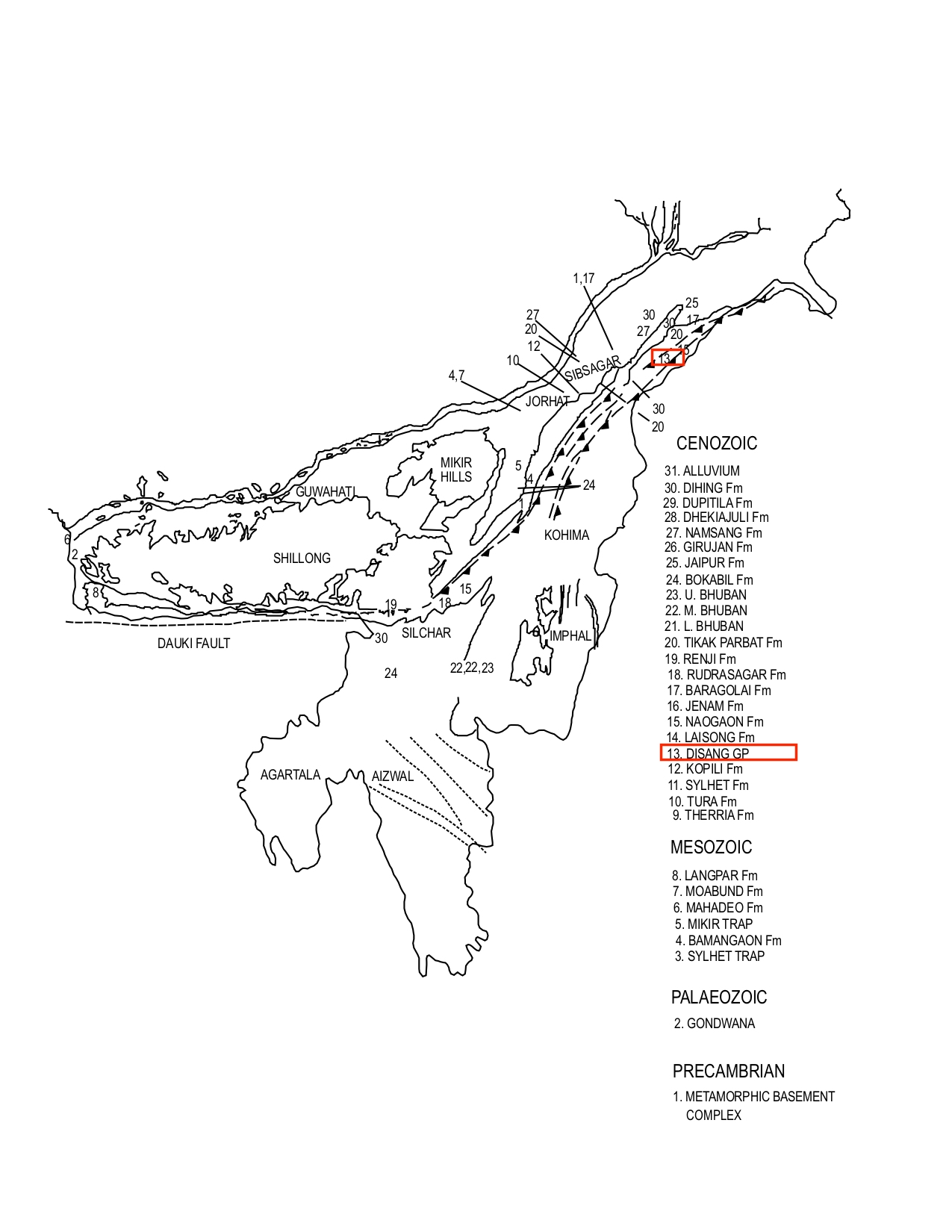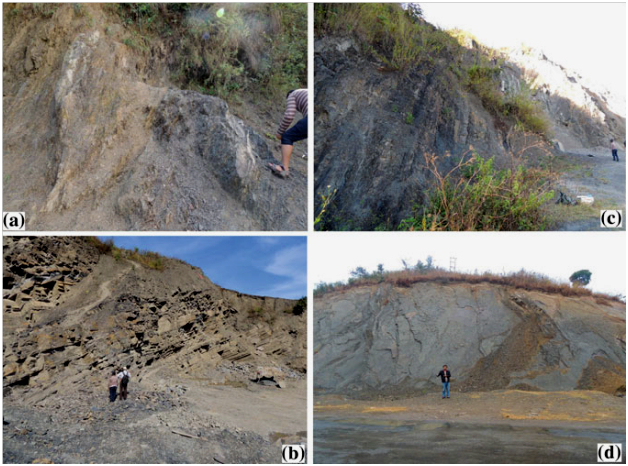Disang Gr
Type Locality and Naming
Local only. Type section is in the Disang (Dilli) river section of Upper Assam. [Original Publication: Mallet, F. R., 1876. On the coal fields of Naga Hills bordering the Lakhimpur and Sibsagar districts. Mem. Geol. Surv. India, (1292), pp. 14-94.]. Reference section: Silchar-Halflong road section.
Synonyms: Revised by Evans (1932). Mallet (1876) proposed this litho-unit as Disang Series comprising of a thick argillaceous sequence with sandstones towards top. These sandstones are exposed along Disang (Dilli) River section of Upper Assam. However, Evans (1932) excluded upper sandstone beds from Disang and included them within overlying Barail Gr as the Liasong Fm. Biswas (1961) redesignated the Disang series of Evans as Disang Group. Rao (1983) informally divided the Disangs Group into a Lower, metamorphosed unit, and an Upper, unmetamorphosed sequence in most of the onland (Pandey and Dave, 1998).
[Figure 1: Formation stratotypes of North East Basins (modified after Pandey and Dave, 1998)]
Lithology and Thickness
Claystone. The Disang Group of rocks comprises mainly shale, siltstone and fine-grained sandstone. It is divided into Lower and Upper Disang by Rao (1983).
The Lower Disang comprises metamorphosed and highly deformed slates, phyllites, graphic schists and quartzites. It is exposed in the eastern part of the Kohima-Patkaisyclinoria up to the Naga Ophiolite Belt. It consists of dark grey shales interbedded with thin bands of grey siltstone or fine-grained sandstone.
In general, the frequency and thickness of siltstone/sandstone bands increases towards the top of this group (Upper Disang). The shales are argillaceous and carbonaceous in Lower Disang and more arenaceous in Upper Disang. Therefore, the Upper Disang is comprised of splintery or concretionary shales with characters mentioned above.
The exact thickness of Disang Group is not known, as base is not exposed. It is more than 1500 m in type section and 3000 m in eastern Manipur.
[Figure 2: Splintery shale of Lower Disang at Thanga Ngaram, b: alternation of sandstone and shale of the Upper Disang at lower part of Gelmoul quarry, Churachandpur, c alternation of sandstone and shale of Upper Disang at upper part of Gelmoul quarry (high of man is 1.5 m), d Upper Disangshale at Khunutaba Ching, Kakching. (after Singh et. al., 2015)]
Relationships and Distribution
Lower contact
The Disang Formation overlies the metamorphic basement complex(?) and it not exposed in most sections.
Upper contact
The formation is gradational with the Lasiong Fm of Barail Gr. (NE Basins, SE Bangladesh) or the Burdwan Fm (NW Bangladesh)
Regional extent
Naga Schuppen Belt, Tripura Cachar: It is exposed in a 60 km wide belt, in the south of Haflong-Disang thrust covering Naga Hills, Manipur and North Cachar Hills, Rao, (1983). The Disang Group in North Cachar Hills is made up of splintery shales, rich in carbonaceous matter and fragmented plant material along with thin bands of hard, flaggy sandstones. In Dimapur-Kohima road section, non-calcareous siltstones and silty sandstones are associated with splintery shales. In between Mokokchung and Noklark, the Disang Group consists of alternating shales, siltstones and micaceous sandstones with plant remains.
GeoJSON
Fossils
Baruah et al., (1987) reported Nummulites pengaronensis, N. discorbinus, Discocyclinadispansa, D. eamesi, Pellatispiramadaraszi, P.inflata, Hantkenina alabamensis, Globorotaliacerroazulensis, Globigerina ampliapertura,Pseudohastigerina barbadoensisetc., from Heningkunglwa and Lotsu village, SW of Dimapur.Chungkham and Jafar, (1998) reported foraminifera from the limestone beds within Lower Disang exposed near Ukhrul contains Abathomphalus mayaroensis, Rositacontusa, Dicarinella asymetrica, Gansserina gansseri, Globotruncana aegyptiaca, G. ventricosa, Globotruncanita angulata, G. conica, G. elevata,Margiotruncana sinuosa, Pseudoguembelina excolata, Globotruncana arca, G. stuartia nd Heterohelix globulosa. Lokho et al., (2004) reported Hantkenina alabamensis, Hantkenina liebusi,Cribrohantkenina inflata, Pseudohastigerina naguewichiensis, P. micra, P. barbadoensis, Turborotalia cerroazulensis pomeroli, T. cerroazulensis cocoaensis, Globigerina sp., T. C. cerroazulensis, Chiloguembelina martini, C. cubensis, C. cf. tenuis, Chiloguembelinasp., Globigerinatheka semiinvoluta, Globigerina sp., Nummulites chavannessi, N. pengaronensis, Baggina cojimarensis, B. dominicana, B. dentata, B. subinaequalis, Cibicidoides sp., Cancrismauryae, Cyclammina sp., Lenticulina sp., Praebulimina sp.,Osangularia sp., O. plummerae, Uvigerina continuosa, U. cf. eocaena, U. longa, U. cocoaensis, U. moravia, U. vicksburgensis, U. jacksonensis, U. glabransfrom Upper Disang Formation exposed in andaround Pfutsero of southwest Nagaland. Lhoupenyi and Venkatachalapathy, (2005) reported Hantkenina sp., Turborotaliasp., Globigerina sp., Psuedohastegerina sp., Globigerintheka sp., Morozovella sp.,Chiloguembelina sp., Uvigerinasp., Cyclamminasp.,Triloculina sp., Cibicides sp., Lagenasp. etc. from Disang Group, Senapati District, Manipur State. A collection of fossil pteropods, including some unidentified species, provisionally referable to the families Limacinidae, Creseidae, and Clioidae (?) was reported fromthe late Middle Eocene-Late Eocene beds of the UpperDisang Formation exposed near the town of Pfutsero, Phek District, South Central Nagaland (Assam- Arakan Basin, northeastern India) Lokho and Kumar, 2008.
Age
Depositional setting
According to Brunnschweiler (1966) cyclic sedimentation, graded bedding, slumping, and turbidite features are frequently seen in the Disang sequence. Evans (1964) inferred that the Disang Group may include a deep water facies of the Jaintia and lower horizons. Baruah et al., (1987) suggest that the fossiliferous sequence was deposited in a shallow marine environment ranging from mostly inner to middle shelf zones and also partly to outer shelf zone for a short period. Based on the findings of Uvigerinids, planktonic foraminifers and pteropods suggested upper bathyal zone in Nagaland,Lokho et al., (2004); Lokho and Kumar (2008).
Additional Information

